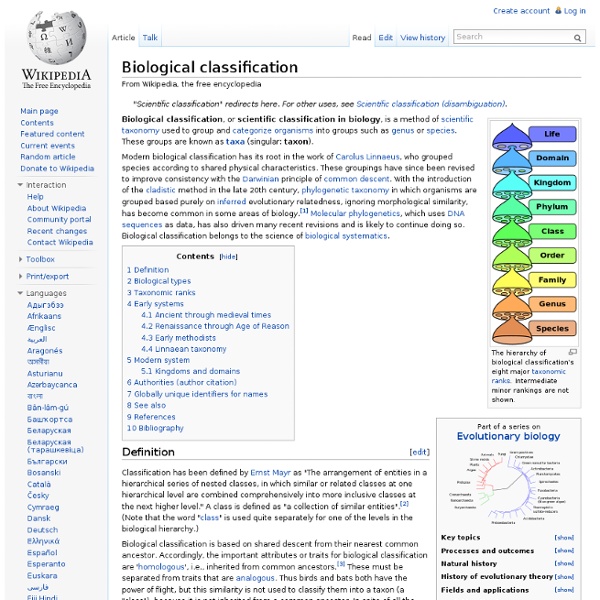Biological classification

Virginia Tech scientist proposes revolutionary naming system for all life on Earth
21-Feb-2014 [ Print | E-mail ] Share [ Close Window ] Contact: Zeke Barlowbzeke@vt.edu 540-231-5417Virginia Tech A Virginia Tech researcher has developed a new way to classify and name organisms based on their genome sequence and in doing so created a universal language that scientists can use to communicate with unprecedented specificity about all life on Earth. In a paper published in the journal PLoS ONE, Boris Vinatzer proposes moving beyond the current biological naming system to one based on the genetic sequence of each individual organism. Vinatzer, an associate professor in the College of Agriculture and Life Science's Department of Plant Pathology, Physiology, and Weed Science, suggests a new model of classification that not only crystalizes the way we identify organisms but also enhances and adds depth to the naming convention developed by the godfather of genus, Carl Linnaeus. Vinatzer does not propose changing the naming convention of existing biological classification.
Lemurs May Hold Secrets To Living Longer, But They Won’t Increase Our Lifespan
When Jonas the fat-tailed dwarf lemur died recently in captivity at the ripe age of 29 years, he was the oldest known of his species. But Jonas not only outlasted members of closely related lemur species held in captivity; he also lived much longer than science would predict based on his small size. A new study in the Journal of Zoology attributed this exceptional longevity to the fact that this lemur species are able to readily enter a low energy state. They can do this for both for long periods of days to months (hibernation), as well as shorter periods of a few hours (known as torpor). Dwarf lemurs live much longer than similar-sized animals. The researchers looked through more than 50 years of records on hundreds of these and three other lemur species at the Duke Lemur Centre. Among mammals, body size correlates with lifespan: larger species live longer than smaller species. The Flame That Burns Twice As Bright In 1908, Max Rubner proposed the first evidence-based theory of ageing.
First Known Plant To Sync Pollen Release To The Light Of The Full Moon
The pull of the moon may be too much for one plant to resist, according to a recent paper published in Biology Letters. The study suggests that the Ephedra foeminea shrub has werewolf-like tendencies, preferring to sprout red and yellow cones and unleash its pollen under the light of the full moon. E. foeminea is the only known plant species in existence that syncs its reproduction to the light of the full moon, in particular during the month of July. The climbing shrub is most often found on cliffs, ravines and bare rocks in regions across the southeastern Mediterranean and further south to Yemen. The gymnosperm reproduces via moonlight pollination in an effort to lure nocturnal insects to its cones. The scraggly shrub does this by secreting sugary drops laden with pollen for insects to find, glinting like treasure under the bright gleam of the moon. “This may be adaptive in two ways," writes Catarina Rydin and Kristina Bolinder of Stockholm University in Sweden. Photo Gallery
Related:
Related:



